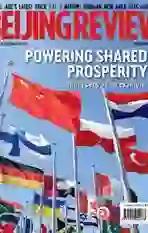Eurasia to Prosper With Joint Effort
2017-10-22ByYuLintao
By+Yu+Lintao
The ancient Silk Roads dating back over 2,000 years were bonds linking Asia and Europe and bridging the civilizations in the East and the West. Now, the Belt and Road Initiative proposed by Chinese President Xi Jinping in 2013 has brought new momentum to Asia-Europe cooperation.
On September 14 and 15, the Boao Forum for Asia (BFA), a platform dedicated to Asian development, held a special meeting themed “Belt and Road: Building Synergy With EU Policies and Strategies” in Paris with promoting infrastructure connectivity between Asia and Europe as a major focus.
In a geographical sense, Eurasia is Earths largest landmass, but the two continents are very different from each other in terms of their economy, history and culture. The Belt and Road Initiative can be seen as an attempt to break down such barriers and help build a community of shared destiny between Asia and Europe.
“In regards to historical norms, the more smooth the road linking Asia and Europe was, the more open they were, and the more frequently exchanges and trade occurred among countries along the Silk Road. And it was the same for economic prosperity and stability as well as peoples livelihoods,” said Zeng Peiyan, Vice Chairman of the BFA, when addressing the meeting.
Infrastructure connectivity is the priority of the Belt and Road Initiative and is also important for building a high-standard free trade network. In the past four years, several railway lines have been opened to connect Asia and Europe. China Railway Corp.s statistics show that 2017 has seen 612 more China-Europe trains so far compared with the same period last year, an increase of 158 percent. At present, on the basis of the new Eurasian Continental Bridge and the Siberian Continental Bridge, China Railway has 51 lines between Asia and Europe planned. By August this year, China-Europe trains had run 4,000 trips, covering 12 countries and 31 cities in Europe.
While meeting Chinese representatives at the BFA Paris Meeting, French President Emmanuel Macron said against the backdrop of the main theme of the BFA meeting this year, the Belt and Road Initiative has served as a vital bridge linking Europe and Asia.
France supports this China-proposed development initiative. According to former Prime Minister Jean-Pierre Raffarin, President Macron has urged Europe to grasp the opportunity that the Belt and Road Initiative presents in order to better achieve connectivity and common prosperity across Eurasia.endprint
“Issues on cooperation are our top priority. Take infrastructure, for example. Weve met technical conditions to jointly take part in some projects. But what we need at the same time is our willingness to cooperate and coordinate our policies,” Raffarin, who is also chairman of the Foundation Prospective and Innovation, cosponsor of the BFA Paris Meeting, said at the event.
BFA Secretary General Zhou Wenzhong echoed Raffarin. Zhou said the Paris meeting would help address some of the core issues on cooperation going forward.
“In terms of economic size, Eurasia accounts for half of the world total. In terms of trade, we account for more than 70 percent of the world total. Questions like ‘can Asia and Europe cooperate well with each other and ‘how to address problems in cooperation still remain. So by holding such a meeting, and by promoting infrastructure building, investment and trade in a manner of mutual benefit and winwin outcomes, we want to help answer these questions,” said Zhou.
To better coordinate the Belt and Road Initiative with European policies, China is making efforts to dock it with the development plans of the EU and its member states, including the EUs Juncker Plan, East European countries16+1 cooperation, Germanys Industry 4.0, and Polands Amber Road.
It is a multi-win move for Asia and Europe to jointly build the Belt and Road, as it runs through the continents of Asia, Europe and Africa. For developing countries alongside the Belt and Road in Asia and Africa, the initiative offers them huge potential for economic development. And for the vibrant economies in East Asia and developed European countries, by promoting connectivity, the initiative can help create a vast market for exports of funds, technology and services, thus promoting the recovery of European economies.
Zeng, in his keynote speech at the Paris conference, also called for closer cooperation between China and Europe. “East Asia and West Europe are two driving forces of global development, and if they strengthen cooperation, common prosperity and development of Eurasia is achievable,” Zeng said.
Zeng added that many countries and regions between West Europe and East Asia urgently need to achieve development and peace, and their people desire a better life. Increased cooperation between China and the EU can help remove the challenges facing such countries and regions.
The two-day meeting attracted more than 300 representatives from 19 nations and regions. Besides infrastructure connectivity, the topics of trade, investment, fi nance and innovation were also included in the discussions.endprint
